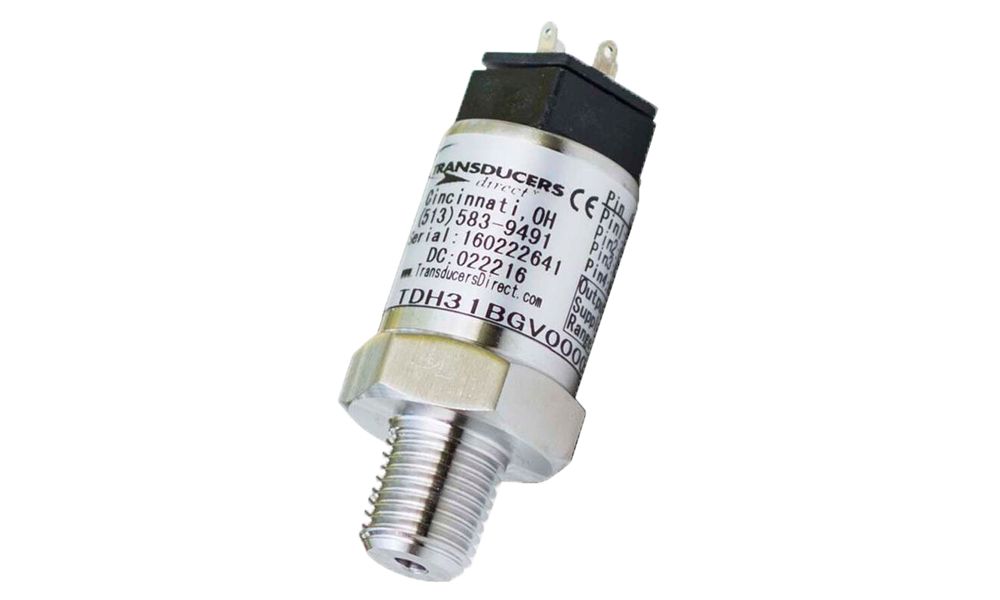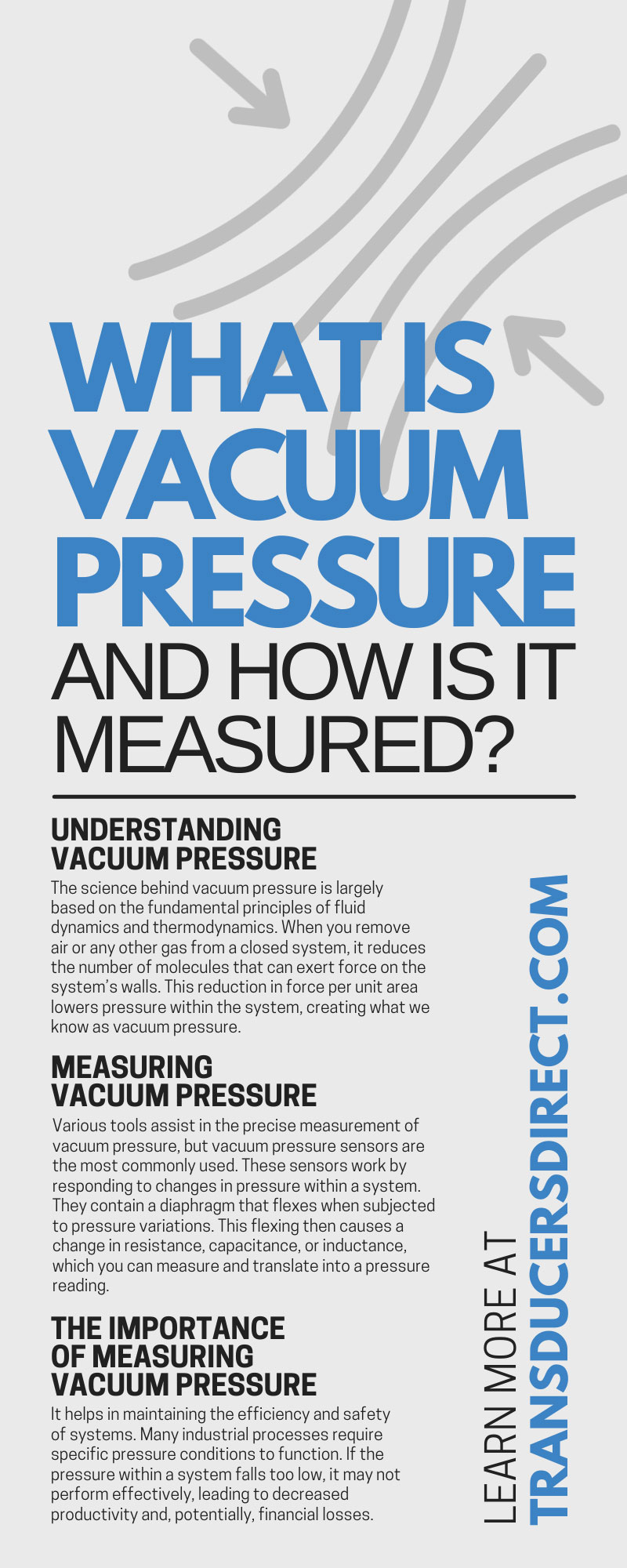What Is Vacuum Pressure and How Is It Measured?

Vacuum pressure is common in numerous industrial applications and processes. It’s a by-product of fluid dynamics and thermodynamics and poses specific hazards to structures, systems, and people.
While it might appear complex at first glance, a solid understanding of vacuum pressure can significantly enhance the efficiency and precision of these operations. But what is vacuum pressure, and how do you measure it? Read on to learn more about the physics behind vacuum pressure, how different tools can help you monitor it, and tips for picking the right equipment for your needs.
Understanding Vacuum Pressure
The science behind vacuum pressure is largely based on the fundamental principles of fluid dynamics and thermodynamics. When you remove air or any other gas from a closed system, it reduces the number of molecules that can exert force on the system’s walls. This reduction in force per unit area lowers pressure within the system, creating what we know as vacuum pressure.
Vacuum pressure, by definition, is the decrease in atmospheric pressure that occurs when a system’s pressure drops below the ambient pressure. This phenomenon often manifests itself in industrial settings where air removal from a closed system creates a pressure difference.
Contrasting vacuum pressure with other forms of pressure illuminates its unique nature. You can measure most types of pressure, such as atmospheric or absolute pressure, relative to a perfect vacuum (zero pressure). However, vacuum pressure measures the disparity between atmospheric pressure and the pressure within the system. Therefore, vacuum pressure is always a negative value, signifying that it is lower than the surrounding atmospheric pressure. The relationship between vacuum, atmospheric, and absolute pressure is an integral part of fluid dynamics and thermodynamics found in many industrial processes, such as refining or water treatment.
Measuring Vacuum Pressure
The process of measuring vacuum pressure involves the application of both physical and mathematical principles. The mathematical calculation for this involves subtracting the system pressure from the atmospheric pressure. However, you should know that these measurements must be in the same units for the calculation to be accurate. This mathematical process provides a quantitative measure of the vacuum pressure within a system.
Various tools assist in the precise measurement of vacuum pressure, but vacuum pressure sensors are the most commonly used. These sensors work by responding to changes in pressure within a system. They contain a diaphragm that flexes when subjected to pressure variations. This flexing then causes a change in resistance, capacitance, or inductance, which you can measure and translate into a pressure reading.
Other tools include vacuum gauges and manometers. Regardless of the specific tool, the pressure measurement it delivers is key in calculating the vacuum pressure. Subtract this value from the known atmospheric pressure (while maintaining similar units) to determine the vacuum pressure!
The Importance of Measuring Vacuum Pressure
So now you know what vacuum pressure is and how to measure it, but why is this information valuable for your industrial operations? Firstly, it helps in maintaining the efficiency and safety of systems. Many industrial processes require specific pressure conditions to function. If the pressure within a system falls too low, it may not perform effectively, leading to decreased productivity and, potentially, financial losses.
Secondly, vacuum pressure plays a vital role in ensuring the safety of these systems. Extreme vacuum conditions can cause equipment to collapse or malfunction, leading to dangerous situations. Operators can take proactive measures to prevent such incidents by monitoring vacuum pressure.
Aside from safety and efficiency concerns, vacuum pressure imbalances can also impact product quality. For instance, during oil refining processes, you need precise control of vacuum pressure to effectively separate different hydrocarbons and ensure quality oil and gas products. This is true for chemical processing operations, too. Also, in scientific research and experiments, understanding and controlling vacuum pressure is often key to achieving accurate results. It allows researchers to create specific conditions needed for their studies. Ultimately, having the right vacuum pressure sensor for your industrial processes is crucial for many reasons.
A Note on Vacuum Pressure Hazards
While excessive levels of vacuum pressure can cause implosions in your system, the likelihood of this occurring in a well-designed system is uncommon. In instances where implosions occur, the cause is often a specific “trigger point”—such as dents or bends in piping—where the system succumbs to the vacuum pressure. You should recognize the destructive potential of vacuum pressure, but rest assured that a well-manufactured and maintained system can withstand accidental elevations in negative forces.
Choosing the Right Vacuum Pressure Sensors
What do you need to look for when selecting the ideal vacuum pressure sensor for your application? Firstly, one must consider the range of pressure the sensor can measure. The sensor should cover the entire range of pressure variations expected in the system to ensure accurate readings. Secondly, the sensitivity of the sensor is a crucial factor. A highly sensitive sensor can detect even minor changes in the pressure, providing more accurate measurements. Additionally, one should also consider the sensor’s durability and reliability. It should withstand the conditions of the environment it will be operating in and consistently provide accurate measurements over its lifetime.
Thankfully, you can find sensors with these qualities and more right here at Transducers Direct! Our sensors can measure a wide range of pressures, making them suitable for various applications. They are highly sensitive, ensuring accurate detection and measurement of even minute changes in pressure. This high level of sensitivity allows for precise control of systems and processes, leading to improved efficiency and productivity. Plus, we manufacture and test all our pressure-sensing equipment in-house, ensuring superior quality control and, ultimately, performance.
Additionally, our sensors will last. We make them from robust materials that can withstand harsh operating conditions, ensuring their longevity. They also undergo rigorous testing to ensure their reliability. Finally, Transducers Direct offers exceptional customer service to support you throughout the whole process, from selecting a sensor to offering after-sales service. So if you’re still confused about the ins and outs of measuring vacuum pressure, feel free to contact our friendly Transducers Direct team today!



Leave A Comment